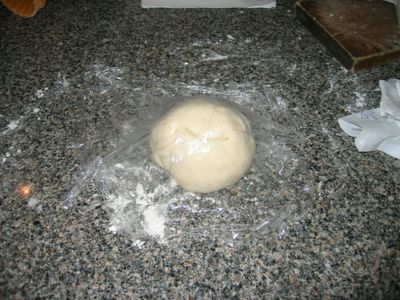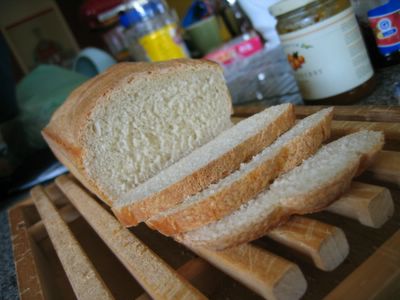359. Basic White Loaf (Basics etc.)
I am, as a rule, scared of yeast cookery. There’s a reason why the basic white loaf is recipe number 359, and not, say, recipe number 8. In the past, when I’ve tried, I get hard lumps of inedible “bread”, which are more like instruments of torture than breakfast treats. The best I’ve done are Nigella’s soft white dinner rolls, which usually turn out really nicely. But a whole loaf has always eluded me.
But in actual fact, the only scary thing about this recipe was sourcing the fresh yeast. I went to Delicatess deli in Prahran Market yesterday morning and plucked up the courage to ask “do you sell fresh yeast?”. They did, and I got about 125 grams. You might only need 30 grams, but ask for anything less than 100grams and they’ll look at you funny. But don’t worry, it’s mega-cheap. I only paid, like, $1.50 for the piece I got. And trust me, once you start successfully baking with yeast, you won’t want to stop. (See How to be a Domestic Goddess for a massive expansion on this theme).
As I mentioned in my last post, I went the whole hog and made a cinnamon babka (a sweet yeasted Jewish twisty bread) at the same time – kneading the babka dough while the bread dough was proving, kneading the bread dough while the babka dough was proving and so on. It’s a fab upper-body workout.
Here’s Nigella’s method for white bread. It was longer and more tedious than I expected, but not too difficult. Just make sure that if you make it, you read all the timings correctly and leave yourself enough time for all the provings.
The first step is to tip flour onto a worktop, and add yeast, salt and sugar.

mound of flour
Then you slowly pour in tepid water with one hand, mixing it to a dough with the other.

ball of dough
Then you knead the dough for 10 (strenuous) minutes until it’s smooth and less sticky, before letting it sit, covered, for 30 minutes.

ball of dough, proved
Now it needs to be kneaded (hah!) for 3 minutes, before another 30-minute proving session. Once that’s done, you have to squish all the air out of the dough, then “Fold it in half, then in half again, and again, and keep folding the dough over itself until it feels as if you can fold no longer”. Then you need to let it prove for another 10 minutes.
At this stage, you shape the dough, and prove it for a final hour before baking it. By this stage, it was late and dark, I still had my cinnamon babka in the oven (pictures to come soon on Sarah Cooks), and Mum needed to use the oven to make dinner. So, I put the plain bread dough in the fridge and let it prove overnight, as Nigella says is perfectly possible (and often desirable) to do.

loaf of bread before final proving
She says that you may need more yeast if you choose the overnight proving option, but this dough seemed to rise without a problem.

risen in the morning
So, after I got up this morning, I baked the dough at 220C for 25 minutes, and the weird squishy white dough became a loaf of bread!

whole loaf - Yay! It looks like real bread!

sliced

With jam
It was great! It looked like real bread! It tasted like real bread! And it was warm and crusty and fresh! I was ecstatic, and my parents liked it too.
I definitely recommend this recipe, and the overnight proving method if you want a delightful breakfast treat.


2 comments:
Well done Sarah! :)
It's amazing how fresh yeast can be so difficult to find in some parts of the world - here you can get it at every shop that sells food. And it's really really really cheap (about 17 Euro cents per 50 grams).
I hope you now have the courage to try more yeast baking! :) It can be really rewarding, I think.
Beautiful loaf, congrts on joining the world of happy bread bakers!
About that fresh yeast, though: do yourself a HUGE favor and forget the fresh yeast. Dry active, instant, fresh, they are all the same yeast. As in: the exact same species of microbiota, just processed differently before being packaged. Mostly tradition! Fresh is simply harder to work with, harder to store, and more expensive. Plus, in a recipe asking fo 30g fresh yeast, you will need only 8g instant or 12g dry active.
Post a Comment